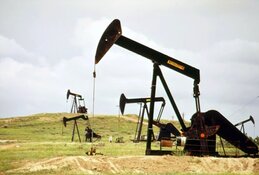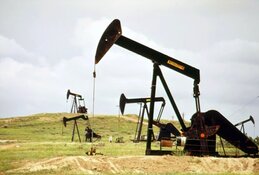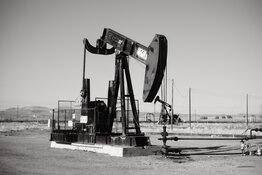Joel Musante: I started covering the sector when I was with W. R. Huff Asset Management after getting my MBA. At Huff, I was a credit analyst, and I performed due diligence on private equity deals. I think this provided a sound foundation for doing any kind of financial analysis. The E&P sector is probably one of the more exciting sectors to cover. Although economic growth may have slowed in the U.S., the emergence of China and India and some of the other Asian economies has us asking how we're going to meet all this future energy demand. For oil and natural gas, the E&P companies have probably been the best at answering that question, as opposed to the majors.
TER: How so?
JM: If you look at some of the big shale plays that have emerged recently—the Haynesville and the Bakken—the leaders in those plays have been the E&Ps. Chesapeake Energy Corp. (NYSE:CHK) put the Haynesville play on the map a couple of years ago. And then EOG Resources (NYSE:EOG) and Brigham Exploration Co. (NASDAQ:BEXP) were on the forefront on the east and west frontiers of the Bakken Shale. Those were among the biggest new shale plays out there.
TER: Brigham is a company you like. Tell us about that one.
JM: Brigham has a lot of acreage in the Bakken play, but the company is probably best known for its results in its Rough Rider area of Williams and McKenzie counties, North Dakota, where its acreage has grown to nearly 150,000 acres. When they started drilling wells at Rough Rider, there weren't many wells drilled out there, and the ones that were drilled were not especially impressive. Brigham decided that if they could use this multi-stage fracking technology to crack up the rock, they may be able to recover more oil. On the west side of the play, the formation was naturally fractured, which allowed for really good well recoveries.
Brigham's initial well results at Rough Rider were encouraging and continued to improve, leading to a de-risking of the area. As the results unfolded, the company's stock performed very well, increasing from just over $1 at the low point of the financial crisis to over $20 within about year.
TER: Another company that you like and that is using technology to its advantage is Evolution Petroleum Corporation (NYSE:EPM). You have a buy rating on that stock. They're testing their proprietary technology called "artificial lift technology" in some of the Giddings oil wells in Texas. Tell us about how that technology works.
JM: The technology is pretty innovative. It consists of a mechanical device that is placed in the horizontal part of the well, below the pump. In many wells, oil and water fills this part of the borehole and cannot be removed by the well pump. The artificial lift device lifts the fluid to the level of the pump, where it can be pumped to the surface.
TER: It's basically increasing efficiency in existing wells.
JM: Yes, but it's not just liquid. If you're able to evacuate the liquid from the borehole, then maybe you can get more gas production, too. Evolution thinks that it can increase well recoveries by about 10%–15% at very little capital cost.
TER: Is there a chance that Evolution could license this technology to other people?
JM: It could potentially be used in thousands of wells that are already in production, especially in the newer wells that are horizontally drilled. Evolution's objective is to license it, but they're still in the testing phase. They're not using it on a wide scale yet.
TER: Is anyone else interested in this technology? Is it being talked about, or are they just doing this on their own?
JM: Evolution has contacted some other companies to encourage them to use it on their wells. They want to collect more data to make a better case to other producers that they should use this technology. You have to get it to a point where someone is going to want to use it. Without sufficient performance data, some operators may be reluctant to interrupt the operation of a well to insert the device.
TER: What are Evolution's prospects beyond "artificial lift" technology?
JM: There's upside potential from the artificial lift technology, but it's not why I recommend the stock. I recommend the stock because I think it's undervalued for its interest in this field in North Louisiana called the Delhi Field. Last year Evolution booked probable reserves of about 13.6 million barrels in that field, and they recorded a present value of future net revenues (PV-10) of nearly $200 million.
TER: What does that mean exactly?
JM: A PV10 value puts a dollar number on the value of reserves in the ground using a discounted cash flow method and assumptions that are guided by the SEC. Using that PV10 value, you can come up with a $6 per share estimate for the stock; it's trading at almost $5 now.
The field is a CO2-enhanced recovery project. The operator of the field was Denbury Resources Inc. (NYSE:DNR). After building a lot of infrastructure, they began injecting CO2 into the field last November and they got a very good response in March. The CO2 flood came on early and the response performed better than expected, leading Denbury to increase its reserve estimates by about 20% for Delhi. Denbury also booked proved reserves in that field. I think that's a good indication that Evolution, which uses the same reserve engineer, will probably also book proven reserves in the field. Those reserves will probably be at a higher volume and a higher value than what they had last year.
TER: So you like it basically due to reserve growth?
JM: Right, I think the reserves are undervalued or underappreciated.
TER: In your research report on Evolution, you said that their oil-to-gas reserve mix is 65% oil and 35% gas. Is that something you're looking for in companies, a mix of both oil and gas?
JM: As these shale plays emerged, it was pretty clear that we were going to have an oversupply of gas and that gas prices were going to be weak for a long time. So I tended to focus more on oily stocks.
There are different categories of reserves and when people talk about reserves, they generally talk about the "proved" reserves. Evolution has a combination of oil, natural gas and natural gas liquids (NGLs), but most of Evolution's reserves are actually in the Delhi Field or will be in the Delhi Field when the company reports reserves the next time. The Delhi Field is their biggest asset and that's 100% oil.
TER: Given that a number of the companies that you cover have an oil and gas mix, is that something of a hedging/diversification strategy? For example, if oil prices go down, maybe natural gas prices go up? Or is that just a coincidence?
JM: A lot of these companies build up their reserve and production base over a long period of time, and it's not something they can change very quickly. So, from historical operations, many of them have a mix of oil and gas on their books. But if you look at where many of them are investing capital, that tends to be in the oilier plays. So going forward, many of the companies I like are growing their oily prospects.
TER: This week oil came off of an 11-week low, but Credit Suisse says that crude stockpiles are growing and that's not going to stop for at least six weeks. What does C. K. Cooper see in store for the oil price this fall?
JM: Well, crude stockpiles are just one of many factors that influence the price of oil; OPEC supply quotas, economic news, political unrest and the strength of the U.S. dollar are some of the others. I think the prevailing forces are going to keep oil prices trading in the $70–$80 range because when you get below $70, development tends to tail off. And that becomes apparent very quickly because the decline rates are steep. There really isn't a lot of positive economic news to sustain oil over $80. I see it hovering in that $70–$80 range.
TER: When you're building models for the next quarter, where are you pegging oil?
JM: For the third quarter, it will probably come in around $75. For the fourth quarter, I am using $80, but that might change as we get closer to that point.
TER: And in terms of building models, how do you weigh the different factors like commodity prices, reserves, exploration potential, management and cash flow?
JM: Well, commodity prices are obviously very important but hard to accurately predict. When I am running models and talking about a net asset valuation model, I generally value the company at $10 increments from $50 to $100 oil. That way an investor can see what the sensitivity to the oil price would be if oil prices fell below a certain level. My price deck is $80 oil and $5 gas. That's a perpetual $80 price; so, in the near term, oil prices might be weaker. But reserves are often estimated from recoveries from wells that may produce for 30 years or more. So a flat $80/Bbl oil price may look high in the near term, but seem conservative in the long term.
And proved reserves provide a good foundation for valuing companies. If I value the proved reserves and then compare that value to the stock price, the stock price could be trading below proved reserve value. If that's the case, it might look undervalued. If it's trading above proved reserve value, investors may be giving the company credit for some other asset, such as a large acreage position in a very prospective or "hot" acreage play.
TER: But how do you value reserves?
JM: I use the SEC reserve information that's provided in the company's filings, which is essentially a discounted cash flow model with a number of assumptions. Basically you're assuming that reserves get developed in the next few years, all of them get produced over time and each year that production generates some cash flow. Then you discount it back to today, and whatever that cash flow is worth in today's terms is the value of the asset.
TER: Let's talk management. Are you out talking to management? Are you visiting projects?
JM: Yes, I am constantly on the phone with managers, and any time I get the opportunity I will go out and visit a company's operation. You can learn a lot when you make these site visits. I think quality of management is important but it's kind of hard to quantify. You look for a company with a sound business plan and people who can execute. There are obviously some managers who are better at it than others. That could be the determining factor of whether value gets created or not, and a lot of times it is.
TER: Do you prefer companies that have a measure of cash flow?
JM: Cash flow is very important for an E&P company. Many large established E&Ps trade on a multiple of cash flow. For a smaller emerging E&P, cash flow is usually less important as a valuation metric, but it may be an important factor that dictates the firm's ability to move a project forward.
TER: It could cover their exploration expenses to some extent.
JM: Right. A lot of times startup companies don't have any proved reserves, and you need proved reserves to borrow money with a credit facility. These companies often need cash flow to finance exploration or development drilling.
TER: Let's talk about some more companies. You cover GeoResources Inc. (NASDAQ:GEOI), an E&P company that had a 42% rise in proven reserves in 2009. You have a buy rating on it. Tell us about that one.
JM: By my estimation, the company appears to be trading at the value of its proved reserves. It's underappreciated because they have this large new acreage position in the North Dakota Bakken play in Williams County. It's a fairly significant acreage position. Based on recent M&A transactions and typical market multiples for acreage in this area, the acreage would be worth about $4–$5 to the share price if it turns out to be prospective.
Recently, a company called Oasis Petroleum Inc. (NYSE:OAS) drilled a well about three miles away from GeoResources' acreage, where the company is planning to drill its first well. Oasis had pretty good well results. The initial production rate from the well was over 1,800 barrels a day of oil. This well helps affirm GeoResources' acreage's prospects.
TER: What factors are you basing that on?
JM: If you look at other operators in the same area or recent transactions, then it looks like that acreage could be worth anywhere from $4,000–$6,000 an acre. GeoResources still has to prove that it works. But if you have 23,000 acres at $4,000/acre, that's about $90 million or about $4.50 to the share price.
TER: What are some other companies you like?
JM: We talked about it before, but I like Brigham Exploration; they're also in the Bakken. It's one of the most recent oil discoveries in North America and it could be quite extensive. The United States Geological Survey (USGS) reported in April 2008 that the Bakken contained 3–4.3 billion barrels of recoverable reserves. Shortly after that, Brigham drilled the west side of the play and began proving up areas that were previously undeveloped. Since then, they've de-risked a lot of their acreage. They have a pretty robust development program in that area, and they have added 53,000 acres recently. I think they're one of the leaders in the play, and they have a development plan that makes a lot of sense.
TER: Do you have some thoughts on the E&P sector or on what's happening with the oil and gas prices?
JM: I'm bullish on oil prices. It's the transportation fuel; it's a worldwide commodity. I wouldn't say we're running out of oil, but there are fewer and fewer places to drill. And the places out there that public companies could drill are becoming more costly, so it's harder and more costly to get it out of the ground.
Then there are large regions where the national oil companies are buying assets to secure supplies. They're not trying to produce oil at the maximum rate or as a public company would. They have longer-term goals, so they're not opening up the spigots.
In terms of natural gas, we've seen the emergence of a lot of large shale gas plays where you can bring a lot of production on very quickly. Even if there were a shortage in natural gas, I think production could be brought on very quickly, so I wouldn't expect prices to remain elevated for long.
A lot of these gas producers have found themselves trying to maintain their leases, so a few of them are drilling wells that are not economical at today's prices. But they're drilling them anyway. That's holding prices down. Until that stops and they start basing their capital allocation decisions on well economics, I think gas prices will continue to be weak.
TER: Thanks, Joel. We appreciate your time.
Joel Musante has been a senior analyst at the Research Group for C. K. Cooper & Company, a full-service investment bank, since July 2007. He has worked as an analyst covering the exploration and production sector for nearly a decade.
Musante began his career in 1998 as an analyst with W.R. Huff Asset Management, performing due diligence on private equity deals and covering the high-yield E&P sector. In 2000, he joined the exploration and production team at Wasserstein Perella, Inc., which later became Dresdner Kleinwort Wasserstein Securities. Mr. Musante also held research analyst positions covering the E&P sector with Ferris, Baker Watts Inc., Zacks Investment Research and John S. Herold, Inc. Prior to working as an analyst, Mr. Musante was a geologist and project manager for seven years with several geological and environmental engineering and consulting firms.
He received an MBA degree with a concentration in finance from the University of Rochester and a BS degree in geology and geophysics from the University of Connecticut. He was awarded the CFA designation and is a member of both the CFA Institute and New York Society of Security Analysts.
Want to read more exclusive Energy Report interviews like this? Sign up for our free e-newsletter, and you'll learn when new articles have been published. To see a list of recent interviews with industry analysts and commentators, visit our Expert Insights page.
DISCLOSURE:
1) Brian Sylvester of The Energy Report conducted this interview. He personally and/or his family own shares of the following companies mentioned in this interview: None.
2) The following companies mentioned in the interview are sponsors of The Energy Report: None.
3) Joel Musante: I personally and/or my family own shares of the following companies recommended in this interview: Brigham Exploration, EOG Resources, Chesapeake Energy, Evolution Petroleum, GeoResources. I personally and/or my family am paid by the following companies mentioned in this interview. None.








































